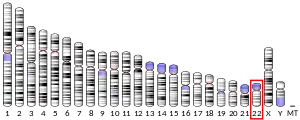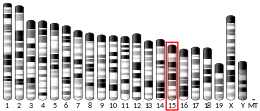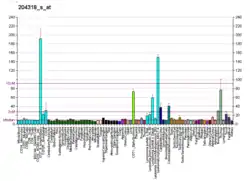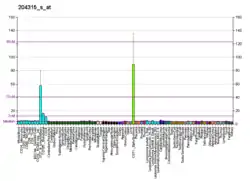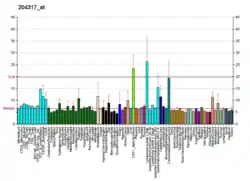GTSE1
G2 and S phase-expressed protein 1 is an enzyme that in humans is encoded by the GTSE1 gene.[5][6][7][8]
The protein encoded by this gene is only expressed in the S and G2 phases of the cell cycle, where it colocalizes with cytoplasmic tubulin and microtubules. In response to DNA damage, the encoded protein accumulates in the nucleus and binds the tumor suppressor protein p53, shuttling it out of the nucleus and repressing its ability to induce apoptosis.[8]
References
- GRCh38: Ensembl release 89: ENSG00000075218 - Ensembl, May 2017
- GRCm38: Ensembl release 89: ENSMUSG00000022385 - Ensembl, May 2017
- "Human PubMed Reference:". National Center for Biotechnology Information, U.S. National Library of Medicine.
- "Mouse PubMed Reference:". National Center for Biotechnology Information, U.S. National Library of Medicine.
- Monte M, Collavin L, Lazarevic D, Utrera R, Dragani TA, Schneider C (Oct 2000). "Cloning, chromosome mapping and functional characterization of a human homologue of murine gtse-1 (B99) gene". Gene. 254 (1–2): 229–36. doi:10.1016/S0378-1119(00)00260-2. PMID 10974554.
- Collavin L, Monte M, Verardo R, Pfleger C, Schneider C (Oct 2000). "Cell-cycle regulation of the p53-inducible gene B99". FEBS Lett. 481 (1): 57–62. doi:10.1016/S0014-5793(00)01969-4. PMID 10984615.
- Monte M, Benetti R, Buscemi G, Sandy P, Del Sal G, Schneider C (Aug 2003). "The cell cycle-regulated protein human GTSE-1 controls DNA damage-induced apoptosis by affecting p53 function". J Biol Chem. 278 (32): 30356–64. doi:10.1074/jbc.M302902200. PMID 12750368.
- "Entrez Gene: GTSE1 G-2 and S-phase expressed 1".
Further reading
- Maruyama K, Sugano S (1994). "Oligo-capping: a simple method to replace the cap structure of eukaryotic mRNAs with oligoribonucleotides". Gene. 138 (1–2): 171–4. doi:10.1016/0378-1119(94)90802-8. PMID 8125298.
- Bonaldo MF, Lennon G, Soares MB (1997). "Normalization and subtraction: two approaches to facilitate gene discovery". Genome Res. 6 (9): 791–806. doi:10.1101/gr.6.9.791. PMID 8889548.
- Suzuki Y, Yoshitomo-Nakagawa K, Maruyama K, et al. (1997). "Construction and characterization of a full length-enriched and a 5'-end-enriched cDNA library". Gene. 200 (1–2): 149–56. doi:10.1016/S0378-1119(97)00411-3. PMID 9373149.
- Dunham I, Shimizu N, Roe BA, et al. (1999). "The DNA sequence of human chromosome 22". Nature. 402 (6761): 489–95. Bibcode:1999Natur.402..489D. doi:10.1038/990031. PMID 10591208.
- Strausberg RL, Feingold EA, Grouse LH, et al. (2003). "Generation and initial analysis of more than 15,000 full-length human and mouse cDNA sequences". Proc. Natl. Acad. Sci. U.S.A. 99 (26): 16899–903. Bibcode:2002PNAS...9916899M. doi:10.1073/pnas.242603899. PMC 139241. PMID 12477932.
- Ota T, Suzuki Y, Nishikawa T, et al. (2004). "Complete sequencing and characterization of 21,243 full-length human cDNAs". Nat. Genet. 36 (1): 40–5. doi:10.1038/ng1285. PMID 14702039.
- Monte M, Benetti R, Collavin L, et al. (2004). "hGTSE-1 expression stimulates cytoplasmic localization of p53". J. Biol. Chem. 279 (12): 11744–52. doi:10.1074/jbc.M311123200. PMID 14707141.
- Beausoleil SA, Jedrychowski M, Schwartz D, et al. (2004). "Large-scale characterization of HeLa cell nuclear phosphoproteins". Proc. Natl. Acad. Sci. U.S.A. 101 (33): 12130–5. Bibcode:2004PNAS..10112130B. doi:10.1073/pnas.0404720101. PMC 514446. PMID 15302935.
- Gerhard DS, Wagner L, Feingold EA, et al. (2004). "The status, quality, and expansion of the NIH full-length cDNA project: the Mammalian Gene Collection (MGC)". Genome Res. 14 (10B): 2121–7. doi:10.1101/gr.2596504. PMC 528928. PMID 15489334.
- Cheng J, Kapranov P, Drenkow J, et al. (2005). "Transcriptional maps of 10 human chromosomes at 5-nucleotide resolution". Science. 308 (5725): 1149–54. Bibcode:2005Sci...308.1149C. doi:10.1126/science.1108625. PMID 15790807. S2CID 13047538.
- Kapranov P, Drenkow J, Cheng J, et al. (2005). "Examples of the complex architecture of the human transcriptome revealed by RACE and high-density tiling arrays". Genome Res. 15 (7): 987–97. doi:10.1101/gr.3455305. PMC 1172043. PMID 15998911.
- Beausoleil SA, Villén J, Gerber SA, et al. (2006). "A probability-based approach for high-throughput protein phosphorylation analysis and site localization". Nat. Biotechnol. 24 (10): 1285–92. doi:10.1038/nbt1240. PMID 16964243. S2CID 14294292.
This article is issued from Wikipedia. The text is licensed under Creative Commons - Attribution - Sharealike. Additional terms may apply for the media files.
